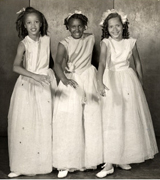The Anacostia Community Museum Archives (ACMA) opened in 2001 in the Smithsonian Institution's newly renovated Anacostia Community Museum, founded in 1967 as the first federally funded neighborhood museum and located in the historic Anacostia section of Washington, D.C. The archives unit collects, preserves, and makes available materials supporting the object-based collection and the research and educational activities of the museum, as well as the museum's mission which is centered on contemporary urban communities.
The Collections
Most of the collections are on-site at the museum's main Fort Place facility but some materials are in off-site storage. Approximately 1000 linear feet of materials, comprising personal papers, manuscripts, exhibit records, local community records, photographs, and special collections, are located at Fort Place. A small selection of Anacostia Community Museum historical and administrative records are kept by the archives and supplement the institutional records held by Smithsonian Institution Archives.
Discrete Collections
Holdings include the personal papers of individuals with national or local reputations. Among these materials include the papers of Frederick Douglass Patterson, Madame Lillian Evanti, Lorenzo Dow Turner, Ethel Payne, Joy McLean, Col. West A. Hamilton, Charles E. Qualls, Ella Pearis, and Alice B. Finlayson. In addition, collections of family papers that document everyday life and family history in diverse communities include the Sullivan, Griffith, Henson, Plummer-Arnold, Harris, Bryan, Lucus, and Robinson-Smith papers. The archives also contain the records of several organizations, such as the Bladensburg Union Burial Association, with records dating from 1874–1978; the Chitlin Market; and the District of Columbia Art Association. Catalog records are available on SIRIS.
Exhibition Records
These records document the museum's myriad exhibits from 1967 to the present and also complement the institutional records held by Smithsonian Institution Archives. Highlights from the collection include: The Anacostia Story: 1609–1930; The Real McCoy: African-American Invention and Innovation, 1619–1930; Climbing Jacob's Ladder: The Rise of Black Churches in Eastern American Cities, 1740–1877; The Harlem Renaissance: Black Arts of the Twenties; Banding Together: School Bands as Instruments of Opportunity; and Black Mosaic: Community, Race, and Ethnicity among Black Immigrants in Washington, D.C. Catalog records are available on SIRIS.
Photographic materials
The archives house over 50,000 images, with the strength residing in the visual documentation of the community, exhibitions, programs, educational, and outreach material spanning the museum's forty-three years. The collection also includes works by historical and contemporary celebrated photographers. Among these photographers are Arthur P. Bedou, Prentice Herman Polk (P. H. Polk), Addison N. Scurlock, Carl Van Vechten, Ernest C. Withers, Robert H. McNeill, Titus Brooks Heagins, Kerry Coppin, Dennis C. Calhoun, and Fern Logan. In addition, the Dorn C. McGrath Jr. slide collection dates from 1969 to 2000 and provides an extensive resource of the built and natural environment of the Anacostia community.
Special Collections
The archives include over 200 volumes of books dating from the early 19th century to the present. Poems on Various Subjects Religious and Moral by Phillis Wheatley is the earliest publication in the collection. Posters, sheet music, pamphlets, vertical files, and audiovisual materials are also among the holdings in the Anacostia Community Museum Archives.

Henry Bazemore Collection of Frederick Douglass Dwellings Photographs
Anacostia Community Museum Archives
Anacostia Community Museum
1901 Fort Place SE
Washington, DC 20020
202.633.4853
Hours
Monday, Wednesday, Friday
10am to 12pm and
1pm to 4:30pm
Appointment Required
Metro Stop: Anacostia